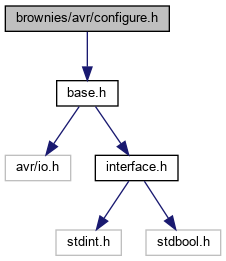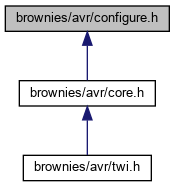|
Home2L - C/C++ API v1.4-2-g83f4c (2025-08-23)
Smart Tools for a Private Home
|
|
Home2L - C/C++ API v1.4-2-g83f4c (2025-08-23)
Smart Tools for a Private Home
|
#include "base.h"

Go to the source code of this file.
Macros | |
| #define | ISR_PCINT0 |
| Interrupt vector: pin change 0. | |
| #define | ISR_PCINT1 |
| Interrupt vector: pin change 1. | |
| #define | ISR_USI_STARTCOND |
| Interrupt vector: USI start condition. | |
| #define | ISR_USI_OVERFLOW |
| Interrupt vector: USI overflow. | |
| #define | P_USI_SCL |
| TWI slave SCL ('twi_sl_scl') | |
| #define | P_USI_SDA |
| TWI slave SDA ('twi_sl_sda') | |
| #define | GPIO_PINS_MAX |
| GPIO: Maximum number of pins usable as GPIOs. | |
| #define | GPIO_TO_PMASK(GMASK) |
| GPIO: Map a logical GPIO mask to MCU port A/B mask (see also GPIO_FROM_PMASK). | |
| #define | GPIO_FROM_PMASK(PMASK) |
| GPIO: Map MCU port mask to a logical GPIO mask. | |
| #define | P_TWI_MA_0_SCL |
| TWI master: SCL pin. | |
| #define | P_TWI_MA_0_SDA |
| TWI master: SDA pin. | |
| #define | P_ADC_0 |
| ADC (0) pin. | |
| #define | P_ADC_1 |
| ADC 1 pin. | |
| #define | P_UART_RX |
| UART receive pin. | |
| #define | P_UART_TX |
| UART transmit pin. | |
| #define | P_UART_DRIVE |
| UART driver enable (set to 1 during transmission) | |
| #define | P_TEMP_ZACWIRE |
| Temperature: ZACwire data pin. | |
| #define | P_SHADES_0_BTN_UP |
| Shades (0): button "up" pin. | |
| #define | P_SHADES_0_BTN_DN |
| Shades (0): button "down" pin. | |
| #define | P_SHADES_0_ACT_UP |
| Shades (0): actuator "up" pin. | |
| #define | P_SHADES_0_ACT_DN |
| Shades (0): actuator "down" pin. | |
| #define | P_SHADES_1_BTN_UP |
| Shades 1: button "up" pin. | |
| #define | P_SHADES_1_BTN_DN |
| Shades 1: button "down" pin. | |
| #define | P_SHADES_1_ACT_UP |
| Shades 1: actuator "up" pin. | |
| #define | P_SHADES_1_ACT_DN |
| Shades 1: actuator "down" pin. | |
General ... | |
| #define | IS_MAINTENANCE 0 |
| This firmware is a maintenance system? | |
| #define | TWI_SL_NOTIFY (!IS_MAINTENANCE) |
| Device may perform notifications via its slave interface? | |
| #define | TWI_SL_NOTIFY_US 10000.0 |
| Duration of a notification in microseconds. | |
Timer ... | |
| #define | WITH_TIMER 0 |
| The timer is enabled if this is 1 or any other feature requires the timer. | |
GPIO ... | |
| #define | GPIO_IN_PRESENCE 0 |
| Pins to be used as general-purpose inputs. | |
| #define | GPIO_IN_PULLUP 0 |
| Inputs with activated internal pullups. | |
| #define | GPIO_OUT_PRESENCE 0 |
| Pins to be used as general-purpose outputs. | |
| #define | GPIO_OUT_PRESET 0 |
| Output default state (will be set before Z-state is left) | |
TWI Master / Hub ... | |
Note: Presently, only a single TWI master is supported, which then acts as hub, i.e. all requests/replies to other nodes of the same subnet are forwarded via the master port currently set (#0 at present). In the future, this may change: There may be multiple master ports, and master ports may be used independently of the hub functionality - for example, to work with i2c devices locally. | |
| #define | WITH_TWIHUB 0 |
| Enable TWI hub functionality over master port #0. | |
| #define | TWIHUB_PORT 0 |
| TWI master port to use for the hub (must be 0 presently). | |
| #define | TWI_MA_PORTS (WITH_TWIHUB ? 1 : 0) |
| Number of TWI master ports. | |
| #define | TWI_MA_INTERNAL_PULLUP 0 |
| Activate internal pullups for the master SCL/SDA lines (DEPRECATED). | |
Matrix ... | |
The diode switch matrix uses the pins avaliable as GPIO for the MCU, which may then not be used as GPIOs. If MATRIX_ROWS > 1, the last MATRIX_ROWS ports are the stimulation ports. The MATRIX_COLS ports before those (or the last ports at all, if no stimulating ports exist) are the sensing ports. In the special case of MATRIX_ROWS == 1, no stimulation ports are assigned, and no active stimulation is performed by the software module. In the circuitry, the row lines of the switches should be connected to VCC (i.e. constantly be pulled high via some resistor) instead of a stimulation port. | |
| #define | MATRIX_ROWS 0 |
| Number of stimulating lines (rows) (max. 8). | |
| #define | MATRIX_COLS 0 |
| Number of sensing lines (columns) (max. 8). | |
| #define | MATRIX_COLS_GSHIFT (MATRIX_ROWS_GSHIFT - MATRIX_COLS) |
| Index of the first GPIO pin to be assigned to column lines. | |
| #define | MATRIX_T_SAMPLE 4 |
| Time (ticks) a row is driven to 1 to sample. | |
| #define | MATRIX_T_PERIOD 16 |
| Time (ticks) before switching to the next row. | |
| #define | MATRIX_BUFSIZE 8 |
| Event buffer size. | |
ADCs ... | |
| #define | ADC_PORTS 0 |
| Number of ADC input ports (max. 2) | |
| #define | ADC_PERIOD 1024 |
| Sample period in ticks (max. 32767) | |
| #define | P_ADC_0_STROBE 0 |
| Pin to output a strobe signal before each sampling (0 = no strobe) | |
| #define | ADC_0_STROBE_VALUE 1 |
| Strobe value (the other times, the pin drives the opposite value) | |
| #define | ADC_0_STROBE_TICKS 0 |
| Duration of a strobe if ADC_STROBE_PIN != 0. | |
UART ... | |
| #define | WITH_UART 0 |
| Enable UART. | |
| #define | UART_WITH_DRIVE 1 |
| Enable "driver enable" output (e.g. for RS485) | |
| #define | UART_TX_LISTEN 10 |
| If "drive enable" is set, this is the number of milliseconds to await silence before sending. | |
| #define | UART_TX_INV 1 |
| Set to invert TX output (e.g. for RS485 via MAX485) | |
| #define | UART_RX_INV 1 |
| Set to invert RX input (e.g. for RS485 via MAX485) | |
| #define | UART_BAUDRATE 9600 |
| Baud rate. | |
| #define | UART_STOPBITS 1 |
| Stop bits. | |
| #define | UART_PARITY 0 |
| Parity (0 = none, 1 = odd, 2 = even) (ONLY 0 IMPLEMENTED YET) | |
| #define | UART_TX_BUFSIZE 16 |
| Capacity of the TX buffer (in bytes, must be power of 2) | |
| #define | UART_RX_BUFSIZE 16 |
| Capacity of the RX buffer (in bytes, must be power of 2) | |
| #define | UART_MULTI_BYTE_ISR 1 |
| Allow to receive multiple bytes (at most UART_RX_BUFSIZE) within one ISR call. | |
Temperature ... | |
| #define | WITH_TEMP_ZACWIRE 0 |
| Enable ZACwire temperature interface. | |
| #define | TEMP_NOTIFY 0 |
| Enable bus notification for temperature changes (does not affect BR_REG_CHANGED). | |
Shades ... | |
The 'shades' module allows to control up to two window shades (blinds) or actuators in a wider sense (e.g. including actuators to open/close windows or gates). Each actuator is associated with two output pins to active its engine in the "up" or "down" direction and two input pins connected to two push buttons for the two directions. Note on the shades ports:
| |
| #define | SHADES_PORTS 0 |
| Number of (shades) actuators (max. 2) | |
| #define | SHADES_TIMEOUT 30000 |
| Number of milliseconds without connection before the brownie assumes that the master is offline. | |
| #define | SHADES_REVERSE_DELAY 1000 |
| Minimum time (in ms) the actor is kept off before it is switched on again (either in the same or other direction). | |
| #define | SHADES_0_RINT_FAILSAFE 0xff |
| Failsafe internal request value(s) (RINT) for the case the brownie has lost its connection to the master (-1 = RINT is not changed on time-out). | |
| #define | SHADES_PERSISTENCE 1 |
| If set, the position is stored in EEPROM to minimize calibrations. If unset, the position is reset to "unknown" on power up. | |
| #define | SHADES_TOLERANCE 2 |
| Tolerated deviation between the real and requested position in %. If the difference between real and requested state is no more than this, shades are not started to move. | |